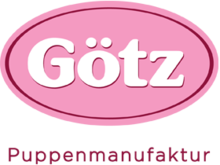Götz (company)
You can help expand this article with text translated from the corresponding article in German. (July 2017) Click [show] for important translation instructions.
|
This article needs additional citations for verification. (July 2017) |
 | |
| Company type | Gesellschaft mit beschränkter Haftung |
|---|---|
| Götz | |
| Industry | Toys |
| Founded | 1950 in Rödental, Germany |
| Founder | Marianne and Franz Götz |
| Headquarters | Rödental, Germany |
Area served | Worldwide |
| Products | Dolls and related toys |
| Website | www |
Götz Puppenmanufaktur International[a] (often referred to as Götz Puppenfabrik or Goetz) is a German toy manufacturer, founded in Rödental, Germany, in 1950. This company was recognized internationally for their doll lines. Marianne and Franz Götz were the founders of Götz Puppenfabrik.[3] The company is known to have inspired the classic face mold of the American Girl doll line back when the doll line was owned by Pleasant Rowland.[1]
History Timeline
1950: Götz Puppenfabrik was founded in 1950, by Marianne and Franz Götz. Franz Götz personally sold and delivered the dolls to their first customers. Götz built the dolls out of papier-mâché initially.[4]
1957: The doll parts were produced using the first model of the rotation-molding machine.[4]
1964: The first reproductions of Sasha Morgenthaler's original artist dolls were manufactured. [4]
1986: Pleasant Rowland, the creator of American Girl, used the model of a Götz branded doll when she presented her idea to create Pleasant Company.[5]
1987: An American secondary branch location of the company was created in Baldwinsville, New York.[4]
1989: Carin Lossnitzer's and Sylvia Natterer's artist dolls were reproduced, leading to an increased consumer base.[4]
1990: A Hungarian and Budapest production center and secondary location were built.[4]
1992: The doll company was given the "Spiel Gut" award.[4]
1994: A Hungarian retail franchise was founded.[4]
1997: Götz Puppenfabrik partnered with Pampolina, another doll company. A doll-and-child clothing line was released, in which children can wear the same outfits as their dolls.[4]
1999: The second generation, Götz Family Anke Götz-Beyer and Uwe Beyer, claimed the corporation management.[4] In Radisson, an American franchise and manufacturing plant of Goetz Dolls Inc. (another name for the company) was opened.[6]
2000: Götz Puppenfabrik received the licensing of "Unser Sandmännchen." [4]
2003: Due to the declining popularity, the final shipment of Götz Puppenfabrik dolls were ordered in Radisson.<ref>Niedt, B. (2003, Sep 25). On the Shelf; Maker of Gotz Dolls to End Manufacture; Analyst: Doll Collectors Are an Aging Market [FINAL EDITION]. The Post - Standard. ProQuest 325836884/ref>
2005: A partnership was formed with the Margarethe Steiff GmbH company. The company was given the license, "Hase Felix," in conjunction with the release of a doll from the film, "Felix - Ein Hase auf Weltreise."[4]
2007: "Just Like Me" dolls were introduced as a concept.[4]
2011: "Haarwerk," a toy collection of cosmetics with styling heads, an enlarged version of the doll head that cuts off at the shoulders, was released. [4]
Notes
References
- ^ a b Balousek, M. (2003). Pleasant Rowland. In Famous Wisconsin Inventors & Entrepreneurs. Oregon, WI: Badger Books. Retrieved from https://books.google.com/books?id=6ath04bCE28C&pg=PA31&dq=Götz Puppenfabrik Doll Company Business Information -sale&hl=en&newbks=1&newbks_redir=0&sa=X&ved=2ahUKEwimtrabrb3lAhWNqp4KHQEPCrMQ6AEwAXoECAMQAg#v=onepage&q=Götz Puppenfabrik Doll Company Business Information -sale&f=false
- ^ Gimenez, J.B. 2015, December 23. Journeygirlkelsey Instagram Amber American Girl.jpg. Retrieved from https://commons.wikimedia.org/wiki/File:Journeygirlkelsey_Instagram_Amber_American_Girl.jpg
- ^ History. (n.d.). Götz Puppenfabrik. Retrieved September 27, 2019, from https://www.goetz-puppen.de/en/home.html.
- ^ a b c d e f g h i j k l m n History. (n.d.). Götz Puppenfabrik. Retrieved September 27, 2019, from https://www.goetz-puppen.de/en/home.html.
- ^ Balousek, M. (2003). Pleasant Rowland. In Famous Wisconsin Inventors & Entrepreneurs. Oregon, WI: Badger Books. Retrieved from https://books.google.com/books?id=6ath04bCE28C&pg=PA31&dq=Götz Puppenfabrik Doll Company Business Information -sale&hl=en&newbks=1&newbks_redir=0&sa=X&ved=2ahUKEwimtrabrb3lAhWNqp4KHQEPCrMQ6AEwAXoECAMQAg#v=onepage&q=Götz Puppenfabrik Doll Company Business Information -sale&f=false
- ^ Niedt, B. (1999, Aug 04). Goetz Dolls Up a Factory Store Maker of High-End Dolls Also Sells T.C. Timber Toys in Radisson: [FINAL EDITION]. The Post - Standard. ProQuest 325416876
